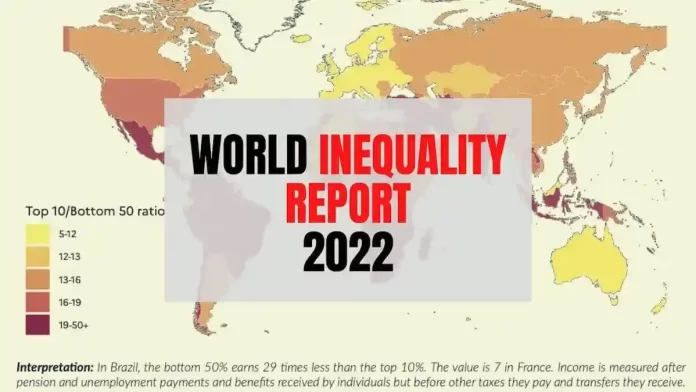Recently, World Inequality Lab, a research center at the Paris School of Economics, released the World Inequality Report 2022.
The report highlights growing wealth and income inequalities across the world. Several of its findings especially regarding India are shocking.
As per the report, there is more inequality in India today, than it used to be in the late Mughal and British times.
The report specifically blames government policies like liberalization and privatization for rising inequalities all over the world. It claims that “inequality is always a political choice”.
Global Trends on Inequality and India
As per the report, the richest 10% of the global population own 76% of all wealth. In contrast, the poorest half of the global population barely owns just 2% of the total wealth.

When it comes to Income, the richest 10% of the global population takes home a whopping 52% of global income. But the poorest half of the population gets only 8.5% of it.
According to the report, the Middle East and North Africa (MENA) are the most unequal regions in the world. Here the richest 10% earn 58% of total income.
However, India is not far behind MENA when it comes to income inequality. If in the MENA region, the share of the top 10% of the population is 58%, in India it is 57%.
In fact, income inequalities in India are more pronounced due to its large population compared to the MENA region.
World Inequality Report: India-specific findings
As per the report, India is now among the most unequal countries in the world.
In India, while the top 10% owns 64.6% of the national wealth, the bottom 50% only barely owns 5.9% of the total national wealth.
Regarding incomes and earnings, the bottom 50% of the population earns roughly INR 53,610/-, the top 10% earns 20 times more i.e. INR 1,166,520/-.
The report states that India stands out as a poor and extremely unequal country, with an affluent elite.
India is more unequal today than in Mughal and British times
In a shocking finding, the report also states that contemporary India is even more unequal than it used to be under the late Mughals and British rule.
The report shows that during the 1820s (late Mughal rule), the top 10% owned 48% of national income, which reached 50.6% in the 1940s. Today, the top 10% in India own over 57% of the national income.

During the colonial rule (1858-1947), the share of income of the top 10% Indians was around 50% which got reduced to 35-40% a few years after independence.
The report credits the socialist policies and five-year plans reducing this share to 35-40%.
Liberalization and Inequality
The report states that since the mid-1980s, deregulation, privatization, and liberalization policies have sharply increased wealth and income inequality in India.
The report states that only the top 1% has benefited immensely from economic reforms.
Growth and development amongst the rest of the population especially in the middle-income groups have been low. Consequently, large-scale poverty still persists in a large number of Indians.
The report also criticizes the incumbent government over the quality of inequality data it has released for the past three years which it calls seriously deteriorated.
It seems some writers or researchers of the report are ideological adversaries of the current government, given the glaring criticism of its policies and intent.
Recommendations: How to bridge Inequalities?
Broadly speaking, the report recommends welfare-oriented socialist policies to overcome rising inequalities.
It advocates drastic policy changes at the government level to curb wealth and income disparities.
Further, it recommends significant redistribution of income and wealth to bridge the rising inequality in the world.
It suggests that governments should resort to modest progressive taxes to augment their revenues. The increased revenues, it states must be reinvested in education, health, and the ecological transition.
The report authoritatively claims that “inequality is always a political choice”. And hence, drastic policy changes are necessary to achieve fairer development outcomes.
A Word of Caution
Finally, given the glaring criticism of the current government, its intent, and policies, at least some writers or researchers of the report seem to be its ideological adversaries.
However, that in and of itself does not render the findings false. Because even commissions appointed by BJP governments have also highlighted a similar state of inequality in India.
For instance, in 2002, the National Commission to Review the Working of the Constitution also pointed out that, the richest top 20% of the population has 85 percent of the income and the poorest 20% has only 1.5 percent of the country’s income, writes M. Laxmikant in the Indian Polity.
Conclusion
There is no denying that the world has seen a steep rise in inequality. Further, this gap between rich and poor has only increased in the post-covid world.
Therefore, governments all over the world must work sincerely to bridge this gap by resorting to all sorts of sustainable and justifiable means at their disposal.
In particular, they need to drastically increase the share of their budgetary spendings on health and social sectors on a priority basis.
